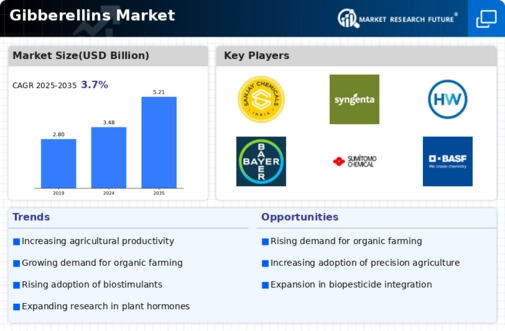Rising Adoption of Organic Farming
The increasing adoption of organic farming practices is significantly influencing the Gibberellins Market. As consumers become more health-conscious and environmentally aware, the demand for organic produce continues to rise. Gibberellins, being naturally occurring plant hormones, align well with organic farming principles. They can enhance crop growth without the use of synthetic chemicals, making them an attractive option for organic farmers. Recent data suggests that the organic farming sector is expected to grow at a rate of approximately 10% annually. This growth presents a substantial opportunity for the Gibberellins Market, as more organic farmers seek effective and sustainable solutions to improve their crop yields and quality.
Increasing Demand for High-Yield Crops
The rising global population necessitates the production of high-yield crops to ensure food security. This demand drives the Gibberellins Market, as gibberellins are known to enhance plant growth and increase crop yields. According to recent data, the use of gibberellins can lead to yield increases of up to 30% in certain crops. As agricultural practices evolve, farmers are increasingly adopting gibberellins to meet market demands. This trend is likely to continue, as the need for efficient food production becomes more pressing. The Gibberellins Market is thus positioned to benefit from this growing demand, as more farmers seek solutions to enhance productivity and sustainability.
Technological Innovations in Agriculture
Technological innovations in agriculture are reshaping the landscape of the Gibberellins Market. Advances in biotechnology and precision agriculture are enabling more efficient application of gibberellins, enhancing their effectiveness. For instance, the development of controlled-release formulations allows for targeted delivery, minimizing waste and maximizing crop response. This trend is supported by data indicating that precision agriculture can increase crop yields by up to 20%. As farmers increasingly adopt these technologies, the demand for gibberellins is likely to rise, as they seek to optimize their agricultural practices. The Gibberellins Market is thus poised to benefit from these innovations, as they facilitate more sustainable and productive farming methods.
Expansion of Horticulture and Viticulture
The expansion of horticulture and viticulture sectors is a notable driver for the Gibberellins Market. As consumers increasingly favor fresh fruits and vegetables, the demand for high-quality produce has surged. Gibberellins play a crucial role in promoting flowering, fruit set, and overall plant vigor, making them essential for growers in these sectors. Recent statistics indicate that the horticulture market is projected to grow at a compound annual growth rate of over 5% in the coming years. This growth is likely to stimulate the use of gibberellins, as growers seek to optimize their yields and improve the quality of their products. Consequently, the Gibberellins Market stands to gain from this trend, as more horticulturists and viticulturists recognize the benefits of these plant growth regulators.
Government Support for Agricultural Productivity
Government initiatives aimed at enhancing agricultural productivity are a key driver for the Gibberellins Market. Many governments are implementing policies and providing subsidies to promote the use of plant growth regulators, including gibberellins, to boost crop yields. This support is particularly evident in regions facing food security challenges, where enhancing agricultural output is a priority. Recent reports indicate that government funding for agricultural research and development has increased, further encouraging the adoption of innovative solutions like gibberellins. As these initiatives continue, the Gibberellins Market is likely to experience growth, as farmers are incentivized to utilize these products to improve their productivity and sustainability.

















Leave a Comment